Distinguished Critique: Justice League: A New Beginning Review
These issues represent a stellar start to a post-Crisis team book equal parts funny and fantastic
—by Nathan on June 30, 2024—
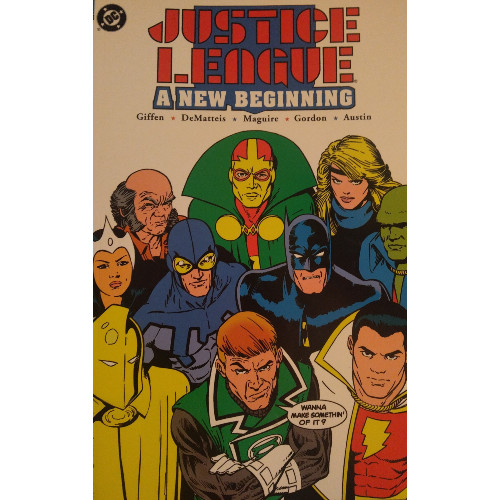
In the wake of Crisis on Infinite Earths and during the post-Crisis crossover event known as Legends, the Justice League disbanded. At least two heroes, Steel (a different character from the John Henry Irons version) and Vibe, had recently been murdered. One other member retired. The old guard was gone, but one lingering member, Martian Manhunter, believed a dedicated group of superheroes was necessary.
As the dust of Legends settled, Darkseid's plan to turn Earth against its heroes backfired, resulting in the reinforced notion that the world was truly in need of its costumed protectors…and that not every battle could be fought alone.
A new team was needed. A new League was needed. As the old universe was torn apart to make a way for a new era of storytelling, so was the old League rendered obsolete for new membership. Guys like Batman, Martian Manhunter, Captain Marvel, Black Canary, and Green Lantern. But not Hal Jordan. No, they got that other guy, Guy. Guy Gardner.
This is gonna end well.
Justice League: A New Beginning
Writer: J.M. DeMatteis
Pencilers: Keith Giffen, Kevin Maguire
Inkers: Terry Austin, Al Gordon
Colorists: Gene D’Angelo, Daniel Vozzo
Letterer: Bob Lappan
Issues: Justice League #1-6, Justice League International #7
Publication Dates: May-November 1987
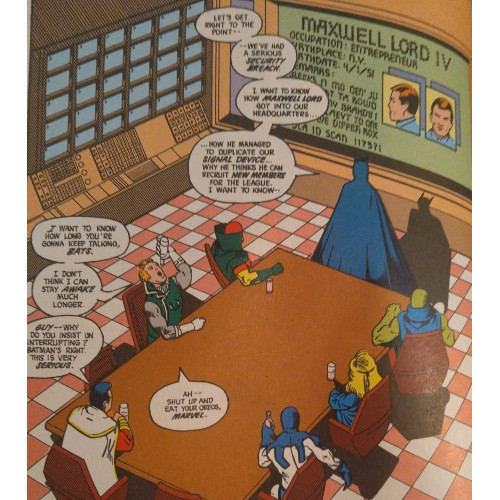
"Born Again" the title of the first issue rings out, and aside from appearing to be a tongue-in-cheek reference to Frank Miller's epic Daredevil story arc of the same name (as well as early evidence of the kind of humor DeMatteis, Giffen, and Maguire would pepper throughout the series), it stands as a bold declaration: out with the old (mostly), in with the new. This is a different League, a group representing the shift in storytelling carried over from Crisis on Infinite Earths while simultaneously bucking the industry-wide trend of making everything a little grimmer, a little darker.
I've never read a pre-Crisis Justice League story, so I cannot comment on the themes and tone evoked in those narratives. Were they serious, tackling resonant thematic issues of the day and age? Were they a series of team-centric explorations and bouts of fisticuffs with bad guys? What I do know is that, commonly, the team consisted of heavy hitters. The Flash, Green Lantern, Wonder Woman, and Martian Manhunter were all founding members. Maybe the Detroit team featured some wannabe A-listers such as Steel and Vibe, but the League had a reputation for top-tier talent.
Which makes DeMatteis and Giffen's decision to pull in what is largely a group of seemingly misaligned misfits all the more surprising.
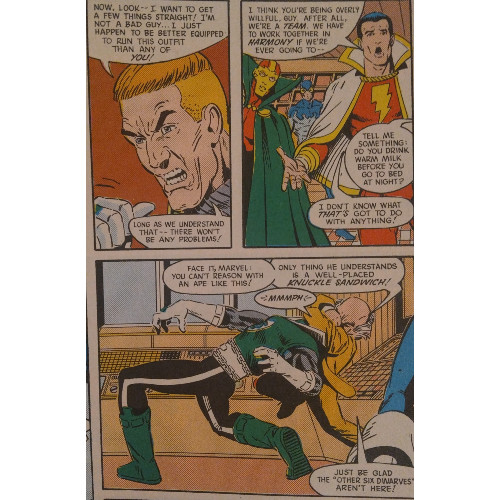
The team dynamic, bolstered by its unique roster of diverse personalities, becomes the crux of these opening issues. This isn't a bunch of do-gooders who decided to band together solely for the betterment of mankind–they're heroes, yes, but they're imperfect. I complained recently of Stan Lee's decision to have the Fantastic Four suddenly become altruistic the moment they gained their abilities, arguing some additional thought should have gone into making such a decision. Not the case here Guy Gardner immediately begins considering how he can wrangle control of the League from the Dark Knight Detective who, rather organically, assumes leadership. Oberon, Mr. Miracle's friend, thinks of the publicity Miracle's membership could land them. Captain Marvel, the pint-sized Billy Batson in superhuman form, approaches the League with some naivety, his (personal) issues becoming apparent as the (physical) issues unfold.
This mishmash of personalities lends DeMatteis and Giffen the material necessary to craft a book which is simultaneously comedic and serious in its portrayal of this new League. Gardner's frequent insubordination leads him into conflict with Batman, allowing for comedic moments underscored by a subtle seriousness. When Batman, fed up by an ill-advised and thoughtless attack by Gardner, punches the disagreeable Green Lantern in the face, Blue Beetle's exclamation of "One punch!" and Black Canary's dismay at missing the moment add a stroke of humor to the panels. Yet the reader who notices this is the culmination of Batman's various frustrations with Gardner and a seeming turning point in their relationship will see the deeper resonances: Gardner's personality, though played for laughs, poses a distinct internal threat to the fabric of the League; for Batman to reach the point where physical violence is necessary to intervene indicates he's a man pushed to his limits and has resorted to the punch to restore order in a way words failed.
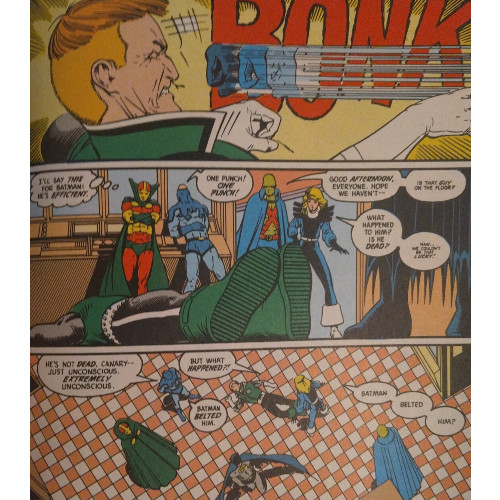
DeMatteis and Giffen toy with several scenes this way, the general lightness of the issues used to form a lens into deeper notions. DeMatteis, no stranger to grim, character-driven narratives, handles the seemingly disparate tones deftly. Wit and banter fly back-and-forth through an arc detailing the League battling heroes from an alternate dimension seeking to wipe out nuclear weapons; scenes and characters provide brief but powerful glimpses into Cold War era conflicts–you may not be as terrified of the Eastern European dictator because he speaks with broken English, but you understand the threat he poses to a cluster of heroes he hopes to trick; the effects of nuclear weapons and chemicals are pointedly driven home through the backstories of characters clearly designed to parody Marvel heroes such as the Scarlet Witch and Thor; and a culminating scene, stripped of one-liners and gags, adds tragedy to the arc, allowing DeMatteis and Giffen to punctuate the sequence with a moment of pure resolve, just so you can take a second to consider the consequences.
In the background, DeMatteis and Giffen also competently maneuver the machinations of one Maxwell Lord, a prominent businessman seeking his own good fortune through promoting the League on a global scale. Again, subtlety is their greatest weapon: Lord offers the series a pseudo-villain, someone bubbling to a boil in the background, who appears (to paraphrase Frodo Baggins) fair but feels foul. DeMatteis does a decent job making the reader feel a tad apprehensive whenever Lord's around, giving him the right words but offering an edge of malice behind them–he's in this wholly for himself, no matter how presentable he appears. He's a silver-tongued schemer, and though I don't know much of the character's history past this point (save his demise at the hands of Wonder Woman during Infinite Crisis), I'd be interested in seeing how DeMatteis and Giffen handled Lord in later issues.
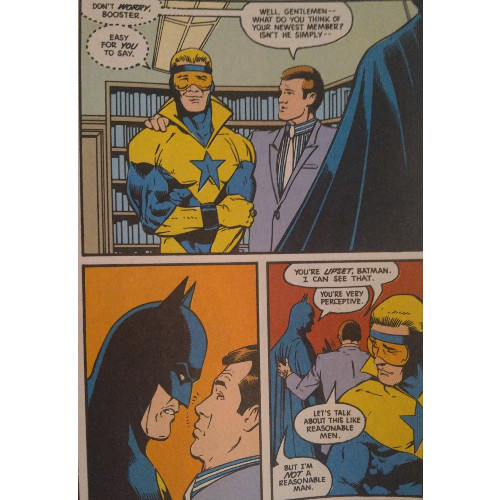
Part of the fun of reading several of these post-Crisis narratives is seeing how they sync up in displaying this new-ish universe, analyzing how Mike Grell's Green Arrow can live in the same world as John Byrne's Superman. Justice League is another piece of that growing puzzle, an updated version of an old team that seems poised for the big leagues. The humor, initially, seems a little out of place–you'd think, when tackling the premier team of the DC Universe, you'd want to establish a more respectable tone–but maybe that's what other creative teams had tried and perhaps that's why, circa 1897, the Justice League was in such turmoil narratively. Maybe shaking things up from the top down was needed to give the team a jolt...and, if blog posts and articles I've read online are to be believed, this new status quo was met by fans eagerly.
The book wouldn't work as well, however, if it was totally comedic, particularly through the art style. Keith Giffen knows to keep all his principle characters grounded and realistic–this isn't Looney Tunes-esque style slapstick we're talking here–but he can deftly craft visual gags as needed. Much of the humor stems from wordplay or how characters behave, but the occasional bit of art adds to the joviality, whether it's Blue Beetle slamming on the brakes of his flying "Bug" before entering another country's airspace or the aforementioned punch of Gardner's kisser. And much like DeMatteis' storytelling, Giffen can use his art to sharp effect when he needs to, such as when an over-confident Booster Gold comes face-to-face with a towering mechanical enemy or when a mind-controlled Captain Marvel barrels towards his friends, enraged and ready to kill. As with the writing, the art straddles a line, effectively achieving the humor as needed while never letting you forget the stakes our new League faces.
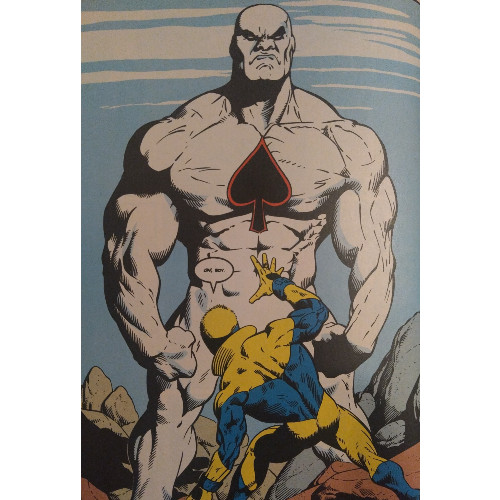
A final note on this title's use of Batman, as of the characters assembled, he's the one I'm most familiar with. In a team book, it's difficult allowing every member their own arc, meaning important moments feel limited to impactful panels or short sequences–for example, Gardner getting decked, Captain Marvel questioning his place within the team, Booster Gold's "audition" by fighting the Royal Flush Gang. But DeMatteis and Giffen's Batman is a mainstay across these issues, serving as a counterweight to Gardner's less tactful nature and as the anchor grounding the team. There's a slight effort to maintain the uber-realistic, dark, gritty take established by creators such as Frank Miller, but DeMatteis should be commended for not allowing the character to become one-note. His Batman is serious, yes, but only when he needs to be. He cracks a joke at one point, yells "Boo!" at a criminal he terrifies. It's a well-rounded approach to the character others would miss by going "Oh, Batman's really serious now, and all he needs to do is jump out of the shadows and punch people." Yes, Batman does that, and that's the "bat" part of the name. But DeMatteis remembers there's a "man" underneath the "bat" and does well to make certain that side is represented.
Not all the characters are given equal weight and not all the jokes land like a solid blow to Guy Garnder's face. But this is a solid beginning to what has become a revered era in Justice League history. The team truly is "Born Again," as the first issue's title states, and I'm beyond thankful they didn't need to have a massive mobster tear their lives asunder for them to rise from the proverbial ashes. They're born again from the Crisis, from the earlier hardships, from the lies of Darkseid himself. Some of them annoy, some take charge, some cry "Holy Moley!" whenever there's danger. The team feels mismatched, almost as if the clashing personalities wouldn't work. But that’s why they do. DeMatteis and Giffin throw in all this chaos and discord to show how, from the emotional detritus, a team can rise and find themselves in a league all their own.